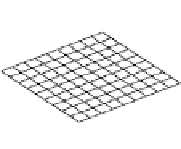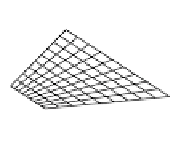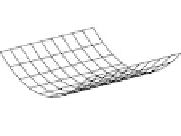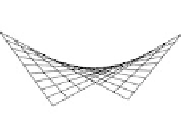Image Processing Reference
In-Depth Information
Figure 6.10:
Comparison of NRSFM using a locally smooth manifold representation of the shape
space
Rabaud and Belongie
[
2008
] (MSFM) with a classical NRSFM method (CSFM)
Torresani
et al.
[
2008
] and with PCA learned from known 3D shapes. Note that the method of
Rabaud and Belongie
[
2008
] is better adapted to cope with this non-smooth deformation of a circular shape. Courtesy of V.
Rabaud. © 2008 IEEE.
Figure 6.11:
Quadratic deformation modes applied to a synthetic planar patch
Fayad
et al.
[
2009
].
Courtesy of A. Del Bue.
especially since existing methods are only reliable when using a small number of basis shapes.
Recently, two publications have advocated the use of alternative models to capture more complex
deformations. The first one
Rabaud and Belongie
[
2008
] exploits the concept of locally smooth
manifold learning (LSML)
Dollar
et al.
[
2007
]. As suggested by Fig.
6.9
, this relaxes the implicit
constraint that the shapes lie on a linear subspace. Instead of optimizing basis shapes and their
coefficients, the 3D coordinates of the object's points are optimized directly, and the resulting shapes
are regularized to form a locally smooth manifold. This is done in an iterative manner. At each
iteration, the manifold is learned from the current shape estimates. This yields a gradient for the
LMSL error term, which is combined with a gradient computed from a temporal smoothness term
explained in Section
6.2
. As shown in Fig.
6.10
, this approach has proved particularly well-adapted
to model large deformations that do not lie on linear manifolds, and therefore cannot be captured
by a linear subspace.
The second approach
Fayad
et al.
[
2009
] to replacing the linear subspace model with a higher-
order one exploits a quadratic deformation model, which was originally introduced in the Computer
Graphics community for simulation purposes
Müller
et al.
[
2005
]. In this case, the shape of a set of





Search WWH ::

Custom Search